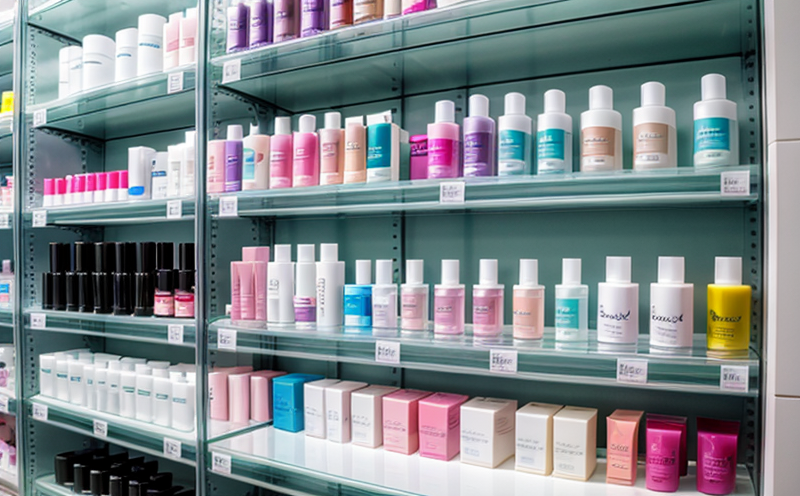Texture and Consistency Stability Testing in Cosmetics
Texture and consistency are critical attributes of cosmetic formulations that significantly influence consumer satisfaction and product performance. In the highly competitive market, maintaining consistent texture and consistency over time is crucial for brand reputation and compliance with regulatory standards. Stability testing focuses on evaluating how these properties change under various environmental conditions to ensure long-term quality and safety.
The process of stability testing involves subjecting cosmetic products to controlled environmental stressors such as temperature, humidity, light exposure, and storage duration. These tests help identify any potential degradation or changes in texture that could affect the product's performance and shelf life. By understanding these factors, manufacturers can make informed decisions about ingredient selection, packaging design, and overall formulation optimization.
The testing method typically involves preparing samples according to specific protocols outlined by industry standards like ISO 25098-1:2014 for cosmetic products. During the test, samples are subjected to conditions that mimic real-world scenarios, including temperature cycling between extremes (e.g., -18°C and 37°C) and humidity levels ranging from 20% to 65%. This ensures that the product's texture remains stable under various climatic conditions.
The analysis of these samples involves a range of techniques tailored to assess different aspects of texture. Rheological measurements are commonly used to evaluate the viscoelastic properties of the formulation, providing insights into its flow behavior and thixotropic characteristics. Microscopy can also be employed to visualize particle size distribution and aggregation tendencies within the product.
In addition to rheological and microscopic analysis, sensory evaluation plays a vital role in assessing texture changes. Trained panels of experts are used to evaluate products based on their appearance, touch, spreadability, and overall feel. This qualitative assessment helps ensure that any deviations from the expected texture are captured accurately.
Reporting the results comprehensively is essential for regulatory compliance and internal quality control purposes. Reports typically include detailed descriptions of test conditions, observed changes in texture over time, and comparisons against baseline samples. These reports serve as valuable tools for product development teams to refine formulations further or make necessary adjustments before market release.
Eurolab Advantages
Eurolab stands out in providing texture and consistency stability testing services with its state-of-the-art facilities equipped with cutting-edge instruments. Our team of experts ensures that each test adheres strictly to relevant international standards, ensuring accuracy and reliability. With a reputation for delivering precise results within tight deadlines, we offer unparalleled support throughout the entire process from sample preparation through final reporting.
One key advantage lies in our commitment to using advanced techniques such as dynamic mechanical analysis (DMA) which provides deep insights into viscoelastic properties under varying frequencies and amplitudes. Additionally, we utilize sophisticated image processing software for detailed microscopic examinations enhancing the precision of our assessments. Our dedicated staff includes experts who are continuously updated on latest methodologies and best practices ensuring that all tests conducted meet highest industry standards.
Eurolab’s commitment extends beyond technical capabilities; it encompasses comprehensive understanding of regulatory requirements relevant to cosmetic products globally. Whether you need assistance navigating complex regulations or require detailed advice regarding formulation changes, our knowledgeable team can provide tailored solutions aligned with your specific needs and goals.
Why Choose This Test
Conducting texture and consistency stability tests is essential for several reasons. Firstly, it guarantees that cosmetic products maintain their intended properties over extended periods, thereby enhancing consumer confidence and satisfaction. Secondly, compliance with regulatory requirements ensures legal adherence which protects both businesses against potential liabilities while fostering trust among consumers regarding product safety.
Furthermore, stability testing facilitates continuous improvement of formulations by identifying weaknesses early in the development process allowing for timely corrective actions to be taken. This proactive approach not only improves product quality but also reduces costs associated with post-market modifications. Lastly, it supports sustainable business practices by optimizing resource utilization and minimizing waste through informed decision-making based on robust data obtained from these tests.
International Acceptance and Recognition
Stability testing of cosmetic formulations is widely recognized and accepted across various international standards bodies. Organizations such as ISO (International Organization for Standardization), ASTM (American Society for Testing and Materials), EN (European Norms) and IEC (International Electrotechnical Commission) have established guidelines that govern best practices in conducting these tests.
For instance, ISO 25098-1:2014 provides specifications for the physical properties of cosmetic products including texture characteristics which are critical during stability testing. Similarly, ASTM D792 has specific criteria applicable to viscosity measurements that could be relevant when evaluating flowability or spreadability aspects within your product line.
Compliance with these recognized standards enhances credibility and ensures consistency in test procedures globally. It demonstrates not only adherence to international norms but also commitment towards maintaining high quality standards which is increasingly important in today’s global marketplace where consumers expect consistent performance irrespective of geographical location or distribution channel.





